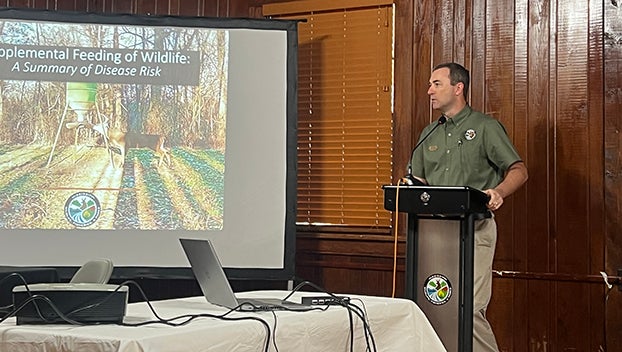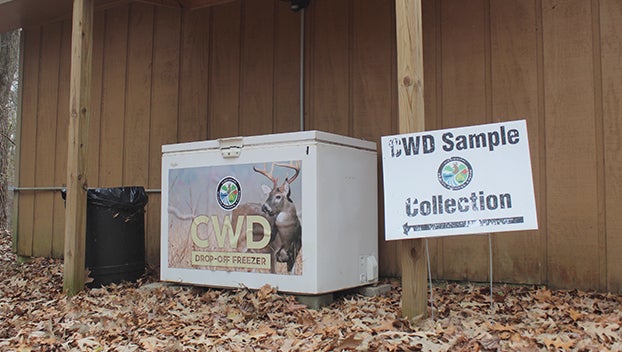Several diseases are a concern with supplemental feeding
Published 4:00 pm Thursday, March 21, 2024

- Wildlife Chief of Staff Russ Walsh speaks on disease management in relation to supplemental feeding Thursday. (Hunter Cloud | The Daily Leader)
MCCOMB — Mississippi Department of Wildlife, Fisheries and Parks Commissioners and the public had an opportunity to learn about supplemental feeding and disease management in an educational session Thursday morning. The session was lead by Wildlife Bureau Chief of Staff Russ Walsh at Percy Quin State Park.
Commissioner Leonard Bentz charged the staff with gathering information on disease management and supplemental feeding at February’s commission meeting. Walsh explained the role supplemental feeding plays in unnaturally congregating animals before he delved into disease risk.
Feeding concentrates animals which allows for diseases to potentially spread from species to species. The concentration around feeders causes deposits of feces, urine and saliva to be greater than in the natural food sources, Walsh said. Deer fecal piles are two times greater at feed sites vs unfed sites and raccoon fecal piles are four times greater at feed sites vs unfed sites.
It is a problem for disease management because the disease vectors are thus concentrated.
He acknowledged the conversation has been about Chronic Wasting Disease but a broader suite of diseases needs to be a part of the conversation.
- Aflatoxicosis is a fungi on feed such as corn where toxins are produced and when ingested poses a risk to wild birds such as turkeys and quail
- Avian pox is a viral infections which causes lesions on turkeys heads and could impact the immune system
- Bovine tuberculosis is a bacteria which causes respiratory problems and rare occasions was passed to humans.
- Brucellosis causes reproductive problems in cattle
- Coccidiosis is a parasite which gets into an animal’s digestive system
- Leptospirosis is a bacteria which can be passed to humans from animal urine
- Toxoplasmosis is a parasitic disease which causes abortion and reproductive failure in cervids and other similar mammals
According to the Center for Disease Control, more than 40 million humans carry Toxoplasmosis but few have symptoms because the immune system keeps the parasite from causing illness.
Research by Mississippi State found Coccidia and nematode concentrations were greater at feed sites by three and two times.
MSU found CWD on feeders in Benton and Marshall Counties in a recent study. The same study found raccoons were carrying CWD prions on their paws.
“There is a risk of movement of disease agents and the risk of contact of disease agents may be carried to other sites,” Walsh said. “We fear the raccoons are picking up the prions and depositing the prions at new feeders.”
Research conducted at MSU found 40 percent of supplemental feeding site visitors were raccoons followed by deer at 25 percent.
Walsh said outside of disease management there is a need to look into the question of if supplemental feeding is benefiting turkeys and raccoons who are potential nest predators of turkeys. Research has already looked at the effect of concentration degrading habitat and how it affects the movement of wildlife which in turn could have an impact on harvest success.
MSU research on deer movement in the Black River Region that was recently published found deer visited feeder sites more often at night. Nearly 36 percent of visits occurred between 6 p.m. to 12 a.m. and 31 percent occurred between 12 a.m. to 6 am. The research suggests hunters may improve chances of seeing adult bucks if they hunt in locations between feeders and bedding sites. Deer were 10 times more likely to visit sites with a feeder and five times more likely to visit sites with food plots than areas of natural vegetation.
Disease management is still the strongest argument for banning supplemental feeding. MSU’s research found the adult bucks were 60 percent more likely to interact at a feeder than a food plot and 300 percent more likely to interact at a feeder than a natural area on the landscape. The paper concludes “With multiple adults bucks interacting at feeders it is distinctly possible that the use of feeders will contribute to increases in the spread and or prevalence of diseases that are transmitted through direct contact with infected individuals such as chronic wasting disease.” CWD is again one of the reasons why a statewide supplemental feed ban is being discussed.
“Wildlife diseases are a significant conservation issue right now,” Walsh said. “What is the risk for humans? Multiple of the diseases are zoonotic and could be picked up by us. Wildlife can be concentrated enhancing disease risk. Not talking about the other factors, the risk is greater than the benefits of feeding.”
He shared a quote with the commission from a Canadian research synthesis paper on the effects of supplemental feeding. “However, given the on-going challenges of addressing wildlife disease issues and the role of baiting, it seems unlikely that diseases will be successfully eradicated or even managed while widespread baiting and feeding is permitted.” Walsh said the quote was the final sentence of the paper.
The summary was just the start of an important conversation. Check back for additional stories sharing what MDWFP Commissioners and the public discussed following the session.





